25 June 2025
Leadership and teamwork—the twin pillars of success in any field. Whether you're in a classroom, a corporate office, or even a sports team, these skills shape the way we navigate challenges and collaborate with others. But here's the million-dollar question: Can these qualities be taught, or are they simply part of our DNA?
Well, the good news is that leadership and teamwork are like muscles—they grow stronger with practice and the right training. And that's exactly where well-structured lesson plans come in. These plans can transform students from passive learners to proactive leaders and team players.
So, if you're an educator, coach, or mentor looking to cultivate these crucial skills in your students, keep reading. Let’s break it down step by step, with engaging lesson plans that make learning leadership and teamwork feel less like a chore and more like an adventure. 
Why Leadership and Teamwork Matter
Before we dive into the lesson plans, let's first talk about why these skills matter. Imagine a world where no one takes initiative, no one listens to others, and everyone works in silos. Chaos, right?Leadership is about stepping up, making decisions, and inspiring others. Teamwork, on the other hand, is about collaborating, communicating, and working towards a common goal. Together, they create harmony in any environment, from classrooms to boardrooms.
Now, let’s get to the fun part—the lesson plans! 
1. The Leadership Icebreaker: Who’s the Leader?
Objective:
To help students recognize different leadership styles and understand the responsibilities of a leader.Activity:
1. Divide the class into small groups.2. Assign one student in each group as the "leader" without telling the rest of the group.
3. Give the groups a complex task, such as building a tower with paper and tape.
4. Observe how their "leader" naturally steps up (or doesn’t).
5. After the activity, discuss leadership styles: Who took control? Who motivated? Who stayed quiet but led by example?
Lesson Takeaway:
Leadership isn’t just about barking orders; it’s about influence, guidance, and decision-making.
2. The Trust Fall: Building Teamwork Through Trust
Objective:
To instill trust and communication within a team.Activity:
1. Pair up students and have one person fall backward while their partner catches them.2. Repeat the exercise but make adjustments—add blindfolds, increase distractions, etc.
3. After each round, discuss trust: What made them hesitate? What helped them feel secure?
Lesson Takeaway:
Great teams are built on trust. If you can’t rely on your team, everything falls apart—literally.
3. Survival Challenge: Problem-Solving as a Team
Objective:
To enhance problem-solving skills and teamwork under pressure.Activity:
1. Present a survival scenario: "You’re stranded on an island, and you have five items. Choose wisely—what would you bring?"2. Each group must decide unanimously on the five most essential items.
3. Afterward, discuss their reasoning—who took the lead? How did they settle disagreements?
Lesson Takeaway:
Effective teamwork means listening, compromising, and thinking critically as a unit.4. The Leadership Debate: Persuasion and Decision-Making
Objective:
To develop leadership confidence, articulation, and decision-making.Activity:
1. Pick a topic (e.g., "Should schools have mandatory uniforms?").2. Assign half the class to argue for the topic and half against.
3. Each team selects a leader who organizes their argument.
4. The debate unfolds, and after, reflect: Who stood out as a leader? Why?
Lesson Takeaway:
True leaders aren’t just loud—they listen, strategize, and communicate effectively.5. Blind Drawing: The Power of Clear Communication
Objective:
To improve communication and leadership through instructions.Activity:
1. Pair up students and give one a simple drawing. The other has a blank paper.2. The one with the drawing must describe it (without naming objects), while the other tries to replicate it.
3. Compare the original drawing with the attempted version.
4. Discuss what worked and what didn’t in their communication.
Lesson Takeaway:
Leaders must communicate clearly because misunderstanding can lead to messy results—just like a bad sketch!6. The Marshmallow Challenge: Leading Under Constraints
Objective:
To promote creative thinking, adaptability, and teamwork.Activity:
1. Give each team 20 sticks of spaghetti, tape, string, and a marshmallow.2. Their challenge? Build the tallest freestanding tower that can support the marshmallow.
3. Set a time limit and observe how they plan, execute, and adjust their strategy.
4. Reflect: How did the leaders emerge? What teamwork challenges arose?
Lesson Takeaway:
Constraints breed creativity, and strong teams adapt under pressure.7. Role-Playing Scenarios: Leadership in Action
Objective:
To help students handle real-life leadership situations.Activity:
1. Present different leadership dilemmas (e.g., "Your team is divided on a decision. How do you handle it?").2. Assign students roles and let them act out solutions.
3. Discuss their responses—what worked? What could be improved?
Lesson Takeaway:
Good leaders make tough decisions while considering everyone's perspective.8. The Silent Teamwork Challenge: Actions Speak Louder
Objective:
To promote non-verbal communication and teamwork.Activity:
1. Assign a task (e.g., build a puzzle, stack cups) but with one rule—no talking.2. Students must work together using only gestures and signals.
3. Afterward, discuss: How did they compensate for the lack of words?
Lesson Takeaway:
Teamwork isn’t just about words—it’s about understanding and adaptability.9. Emotional Intelligence Workshop: Leading with Empathy
Objective:
To develop emotional intelligence and interpersonal skills.Activity:
1. Share different workplace or classroom conflict scenarios.2. Have students role-play handling various situations with empathy.
3. Reflect on the impact of emotional intelligence in leadership.
Lesson Takeaway:
Great leaders don’t just think with their heads; they lead with their hearts too.10. Reflection Journals: The Journey of Growth
Objective:
To help students track and reflect on their leadership and teamwork development.Activity:
1. Provide each student with a journal.2. After each lesson, have them jot down key takeaways.
3. At the end of the series, they share their biggest growth moments.
Lesson Takeaway:
Personal reflection turns experiences into long-lasting wisdom.Wrapping It Up
Leadership and teamwork aren’t skills you pick up overnight. They take effort, practice, and a willingness to step out of your comfort zone. But with the right lessons, students can transform from hesitant followers to confident leaders and effective team players.So, are you ready to guide the next generation of leaders? Because the future is built by those who dare to lead—and those who know how to work together to create something greater than themselves.








Kristy Wells
Great article! These lesson plans effectively foster essential leadership and teamwork skills, preparing students for future challenges. Well done!
November 19, 2025 at 9:46 PM